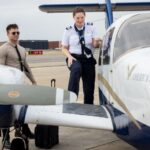By Steven Daun, National Chief Pilot
The dictionary actually has a definition for “back-to-basics,” which is “stressing simplicity and adherence to fundamental principles.” Perhaps the most significant and important word in this definition is “simplicity.”
As airplanes become more technically advanced and support items such as tablets and phones provide more and more information, it is very easy to become dependent on automation. That is, having a computer take the lead rather than the pilot.
When the glass cockpits first came out, most pilots wanted to train with glass because they perceived it to be easier. Simple, just follow the magenta lines, and you will get where you are going. It tells you where Vr, Vx, Vy, and Vne are on the airspeed tape. It tells you your climb and turning tends. It even tells you where the wind is coming from and what heading you should fly. Many pilots end up flying on blind faith in the computer and place 100% of their trust in that little back box to keep them safe.
Our courses have always been built on the back-to-basics philosophy. That is, if you understand the bare bone basics, a pilot will never have to worry about what happens when the glass display goes out. Two years ago, we had a student training for his instrument rating with us. He had a beautiful Cessna 210 and it was upgraded with every modern piece of avionics that could fit in the panel. Our instructor was working with the student in the simulator and unfortunately, the student failed his “automation and glass.” The point of the exercise was to make sure that the student could safely fly his airplane using the standby instruments. He couldn’t. He didn’t even want to try. He got upset, stood up, and walked into the manager’s office to complain. After further discussion, we discovered that he used a G1000 airplane through his entire private pilot course. He had become so dependent on the automation that he was unable to fly an aircraft without it.
At American Flyers, we start all of our private pilot students in a “round dial” airplane: a “six-pack” as it is known. No automation, no computers, just plain raw data. We do this because we know that by learning in a six-pack, the pilot builds their confidence, situational awareness, and understanding of what the airplane is doing in critical phases of flight. It doesn’t take long for the students to understand that they become safer and more confident pilots. We teach them to fly the airplane by reference to the horizon and key power settings. We teach them to feel the aircraft and determine what is happening based on knowledge and experience and not because a line told them to.
Where do we begin? It all begins with attitude flying and an understanding that we have some instruments that help us control the airplane and we have other instruments that tell us about the performance of the airplane. We should consider the outside horizon as an instrument similar to the attitude indicator. The horizon, attitude indicator, and tachometer or manifold pressure gauges are all control instruments. That is, we can control the pitch and bank by reference to the horizon or attitude indicator. We can control the airspeed by reference to the tachometer or manifold pressure gauge. To make it easy to understand you can use this formula. Attitude + power = performance. This means that for every attitude and power setting in a given airplane there will always be a constant performance.
Once we know how to control the airplane, we will need to determine how the aircraft is performing in response to those control inputs. For this we use the airspeed indicator, turn and bank indicator, directional gyro, mag compass, altimeter, and vertical speed indicator. All of these instruments tell us how the airplane is performing in regards to speed, heading, and altitude. If you truly think about this, you will see that you cannot control an airplane just by reference to the performance instruments.
This becomes most evident during instrument training. Students who have learned their primary skills using a six-pack can demonstrate a greater degree of situational awareness and show less apprehension about getting lost or potential emergencies. Why? Because they rely on their raw data skills and use the automation as one additional tool to reinforce what they already know.
Next month, American Flyers is going to begin accepting the delivery of the new Piper Pilot 100i airplanes. One of the reasons we selected the Piper Pilot is because of the avionics. The Garmin G3X flight display can display round dial gauges as well as glass tapes. This fits in line with our training philosophy and will ensure that our students continue to be the best prepared and most proficient in the industry.
If you never learned on a six-pack or don’t feel comfortable flying a round-dial airplane, do something about it. Schedule some time with one of our instructors in a simulator so we can show you what you are missing. Even if you don’t fly around dial airplane, you will see an immediate difference in your situational awareness and decision making skills. Remember, it’s never too late to learn something new.










